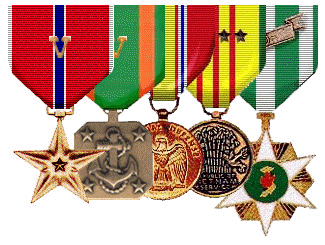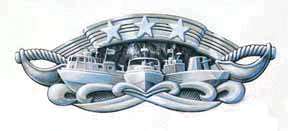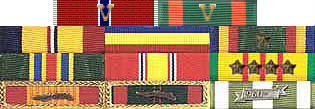
Military Medals and Ribbons
The Navy Mobile Riverine Force, also called the Brown Water Navy, fought mainly in the Mekong Delta portions of III & IV Corps during the Vietnam War. The following are U.S. and Foreign Military Medals won by the author and his unit from July 1968 to July 1969. Be sure to view the Vietnam War Pictures and Memorabilia on the following pages as well.
![]()



![]()
Explanation of Personal and Unit Awards In Order of Precedence
![]()
Bronze Star Medal with Combat "V"
Awarded to any person who, while serving in any capacity with the Armed Forces of the United States, distinguishes himself/herself on or after 7 December 1941 by heroic or meritorious achievement or service, not involving participation in aerial flight.
(a) while engaged in an action against an enemy of the United States;
(b) while engaged in military operations involving conflict with an opposing foreign force; or
(c) while serving with friendly foreign forces engaged in an armed conflict against an opposing armed force in which the United States is not a belligerent party.
(2) To justify this decoration, accomplishment or performance of duty above that normally expected, and sufficient to distinguish the individual among those performing comparable duties is required, although less than the requirements for the Silver Star or Legion of Merit. Minor acts of heroism in combat or single acts of merit or meritorious service in connection with military or naval operations may justify this award.
(3) The recipient must be in receipt of Imminent Danger Pay during the qualifying period.
c. Combat Distinguishing Device. The Combat Distinguishing Device may be authorized for valor (heroism).
( Authorization: SECNAVINST 1650.1G of 1 May 1961, redesignated by SECNAVNOTE of 17 July 1967.)
View Bronze Star Medal w/V Citation
![]()
Navy and Marine Corps Achievement Medal with Combat "V"
Awarded to members of the Armed Forces, including members of Reserve components on active or inactive duty, of the grade of lieutenant commander/major and junior thereto, for service performed on or after 1 May 1961. The award shall be given for meritorious service or achievement in a combat or non-combat situation based on sustained performance or specific achievement of a superlative nature, and shall be of such merit as to warrant more tangible recognition than is possible by a fitness report of performance evaluation, but which does not warrant a Navy and Marine Corps Commendation Medal or higher. The combat distinguishing "V" device is authorized for valor (heroism).
( Authorization: SECNAVINST 1650.1G of 1 May 1961, redesignated by SECNAVNOTE of 17 July 1967. On 19 August 1994, the SECNAV changed the name of the award to Navy and Marine Corps Achievement Medal. )
View Navy Achievement Medal Citation
![]()
Combat Action Ribbon
Authorized on February 17, 1969, this ribbon is awarded to members of the Navy, Marine Corps and Coast Guard for combat action service. The principal requirement is that the personnel must have been in a ground or surface combat fire-fight, or action during which they were under enemy fire, and that their performance under fire must have been satisfactory.
( Authorization: SECNAVNOTE 1650 of 17 February 1969 )
![]()
Presidential Unit Citation
Awarded in the name of the President of the United States to units of the Armed Forces of the United States and co-belligerent nations for extraordinary heroism in action against an armed enemy. The unit must have displayed such gallantry, determination and esprit de corps in accomplishing its mission under extremely difficult and hazardous conditions to have set it apart from and above other units participating in the same campaign. The degree of heroism required is the same as that which would be required for award of the Navy Cross to an individual.
( Authorization: Executive Order 9050, 6 February 1942 )
View Presidential Unit Citation
Navy Unit Commendation
(with bronze service star denoting 2 awards)
Awarded by the Secretary of the Navy to any unit the Navy or Marine Corps which has distinguished itself by outstanding heroism in action against the enemy, but not sufficient to justify the award of the Presidential Unit Citation; or to any such unit which has distinguished itself by extremely meritorious service not involving combat but in support of military operations, rendering the unit outstanding compared to other units performing similar service. To justify this award, the unit must have performed service of the character comparable to that which would merit the award of a Silver Star Medal for heroism or a Legion of Merit for meritorious service to an individual.
( Authorization: ALNAV 224 of 18 December 1944 )
View 1) Navy Unit Commendation 2) Navy Unit Commendation Citations
![]()
Meritorious Unit Commendation
(This award was authorized for service at the Naval Communications Station, Guam)
Awarded by SECNAV, CNO or CMC to any unit of the Navy or Marine Corps which has distinguished itself, under combat or non-combat conditions, by either valorous or meritorious achievement which renders the unit outstanding compared to other units performing similar service, but not sufficient to justify the award of the Navy Unit Commendation. To justify this award, the unit mush have performed service of a character comparable to that which would merit the award of the Bronze Star Medal, or achievement of like caliber in a non-combat situation, to an individual.
( Authorization: SECNAV Notice 1650 of 17 July 1967 )
View Meritorious Unit Commendation Citation
![]()
National Defense Service Medal
Authorized on April 22, 1953 and amended on January 11, 1966, this medal was awarded for honorable active military service as a member of the United States Armed Forces, including the Coast Guard, between June 27, 1950 and July 27, 1954 (Korean War period) and between January 1, 1961 and August 14, 1974, (Vietnam War Period). It has most recently been awarded to active duty military members for service during the Persian Gulf War period.
![]()
Vietnam Service Medal
(With 4 "bronze service stars" denoting (4) specific Named Campaign Periods. )
Authorized on July 19, 1965 and awarded to all service members of the Armed Forces of the United States who, between July 4, 1965 and March 28, 1973, served in Vietnam and the contiguous waters, and airspace, in Thailand, Laos or Cambodia or airspace in direct support of military operations in Vietnam.
![]()
Republic of Vietnam
Meritorious Unit Citation, Gallantry Cross Medal Color, with Palm
(Ribbon Only)
Republic of Vietnam Meritorious Unit Citation (Gallantry Cross Medal Color with Palm) - In addition to those specific units listed, all Navy and Marine Corps personnel who served "in-country" Vietnam are eligible for this award for period 8 Feb 62 - 28 Mar 73 since the Republic of Vietnam Government awarded it to Commander, U.S. Military Assistance Command and all subordinate units.
( SECNAVINST 1650.1H - http://www.marines.mil/Portals/59/Publications/SecNavinst%201650.1H.pdf - Then view Page 7-5 )
Ribbon Only Guidelines - Navy Uniform Regulations
![]()
Republic of Vietnam
Meritorious Unit Citation, Civil
Action Medal, First Class Color, with Palm
(Ribbon Only)
Republic of Vietnam Meritorious Unit (Civil Actions Medal, First Class Color, with Palm)- In addition to those specific units listed, all Navy and Marine Corps personnel who served "in-country" Vietnam during the period 1 Jan 65 - 28 Mar 73 are eligible since the Republic of Vietnam Government awarded it to Commander, U.S. Forces Vietnam and all subordinate units.
(
SECNAVINST 1650.1H -
http://www.marines.mil/Portals/59/Publications/SecNavinst%201650.1H.pdf
- Then view Page 7-5 )
Ribbon Only Guidelines - Navy
Uniform Regulations
![]()
Republic of Vietnam Campaign Medal with 1960's-device
Awarded to members of the Armed Forces of the United States who have served for a six-month period in Vietnam, its surrounding waters or in air support against an armed enemy in Vietnam between March 1, 1961 and March 28, 1973. The time limit is waived if the recipient was killed, wounded or captured at any time before the limit.
![]()

Petty Officer 2nd Class - Radioman / E-5
![]()
VIETNAM CAMPAIGNS PERIODS

1. Vietnam Advisory Campaign
- 15 March 1962 - 7 March 1965
2. Vietnam Defense Campaign - 8 March - 24 December
1965
3. Vietnamese Counteroffensive - 25 December 1965
- 30 June 1966
4. Vietnamese Counteroffensive Phase II - 1 July
1966 - 31 May 1967
5. Vietnamese Counteroffensive Phase III - 1 June
1967 - 29 January 1968
6. Tet Counteroffensive - 30 January - l April
1968
7. Vietnamese Counteroffensive Phase IV - 2 April
- 30 June 1968
8. Vietnamese Counteroffensive Phase V - 1 July -
l November 1968
9. Vietnamese Counteroffensive Phase VI - 2 November
1968 - 22 February 1969
10. Tet 69/Counteroffensive - 23 February - 8 June 1969
11. Vietnam Summer - Fall 1969 - 9 June - 31 October 1969
12. Vietnam Winter - Spring 1970 - 1 November 1969 - 30 April
1970
13. Sanctuary Counteroffensive - 1 May - 30 June 1970
14. Vietnamese Counteroffensive Phase VII - l July 1970
- 30 June 1971
15. Consolidation I - 1 July 1971 - 30 November 1971
16. Consolidation II - 1 December 1971 - 29 March 1972
17. Vietnam Ceasefire Campaign - 30 March 1972 - 28 January
1973
Periods the author was involved in during his tour:
Counteroffensive Phase V ~ 1 July 1968 ~ 1 November 1968.
During this period a country-wide effort was begun to restore government control of territory lost to the enemy since the Tet offensive. The enemy attempted another such offensive on 17-18 August but his efforts were comparatively feeble and were quickly overwhelmed by Allied forces. In the fall of 1968 the South Vietnamese government, with major U.S. support, launched an accelerated pacification campaign. All friendly forces were coordinated and brought to bear on the enemy in every tactical area of operation. In these intensified operations, friendly units first secured a target area, then Vietnamese government units, regional forces/popular forces, police and civil authorities screened the inhabitants, seeking members of the Viet Cong infrastructure. This technique was so successful against the political apparatus that it became the basis for subsequent friendly operations. Government influence expanded into areas of the countryside previously dominated by the Viet Cong to such an extent that two years later at least some measure of government control was evident in all but a few remote regions.
Counteroffensive Phase VI ~ 2 November 1968 ~ 22 February 1969.
In November 1968 the South Vietnam government with American support began a concentrated effort to expand security in the countryside. This project was known as the "Accelerated Pacification Campaign." This period covers the election of President Richard M. Nixon and a change of policy brought about by his administration after January 1969 when he announced a coming end to US combat in Southeast Asia and a simultaneous strengthening of South Vietnam's ability to defend itself. Formal truce negotiations began in Paris on January 25, 1969. The period can be characterized as marking time in preparation for an about face. Forty-seven ground combat operations were recorded during this period, the following being the most important:
(1). Operation NAPOLEON in the Dong Ha area initiated previously (1967) by Marine units, terminated on 9 December 1968.
(2). Operation WHEELER WALLOWA by 3d Brigade, 1st Cavalry Division and 196th Infantry Brigade (Light) in north-central Quang Tin Province. This ended on 11 November.
(3). Operation MACARTHUR initiated by 4th U.S. Infantry Division in II Corps tactical zone terminated on 31 January 1969.
(4). Operation COCHISE GREEN conducted by the 173d Airborne Brigade in Binh Dinh Province.
(5). Operation TOAN THANG II consisted of ground operations throughout III CTZ. This was a multi-division operation involving allied forces.
(6). Operation SEA LORDS was a coast and riverine operation. On 6 December Operation GIANT SLINGSHOT was started to disrupt enemy infiltration of materials from the "Parrot's Beak" area of Cambodia. Air operations continued to be important with over 60,000 sorties flown.
Tet 69/Counteroffensive ~ 23 February 1969 ~ 8 June 1969.
From Tet 1969 through the month of June, the enemy again tried to sustain an offensive. His inability to do so can be largely attributed to aggressive allied ground operations. Between 23 February and 8 June 1969, a total of 70 significant named ground operations were terminated resulting in heavy enemy loss of life and materiel. The main operations concluded during this period were:
(1). The 3d Marine Division's Operation KENTUCKY aimed at preventing enemy infiltration through the Demilitarized Zone in central Quang Tri Province. Throughout the early part of January 1969, Viet Cong/North Vietnamese Army forces continued to avoid major contacts with Free World Forces. Their continual movement to avoid friendly forces or to search for food and supplies contributed to a decrease in the enemy-initiated ground attacks and attacks-by-fire in Quang Tri Province.
(2). Operation NEVADA EAGLE, initiated on 17 May 1968 in Thua Thien Province, continued in 1969 as the U.S. 101st Airborne Division continued to defeat enemy personnel, and capture rice caches, material, and installations within its large area of operations, where it undertook offensive sweeps along Route 547 and around Song Bo.
(3). Two battalions of the 4th Marine Regiment were engaged in Operation SCOTLAND II. Initiated on 15 April 1968, this multi-battalion search and clear operation was centered in and around Khe Sanh.
(4). The IV Corps Tactical Zone Dry Weather Campaign began on 1 December 1968 in support of the overall mission to prevent Viet Cong units from interfering with pacification efforts. This operation, "Speedy Express," interdicted lines of enemy communication and denied him the use of base areas. In 1969 the 1st Brigade, 9th U.S. Infantry Division continued the operation in Dinh Tuong Province, using its highly successful night ambush tactics while the 2d Brigade continued its mission with the Mobile Riverine Force. Although engagements in Operation SPEEDY EXPRESS were typically small, the 9th Infantry Division fought several sizeable engagements with impressive results.
On 23 February U.S. Navy units and installations at Da Nang, Tan An, Ben Luc, Go Dau Ha, and Tra Cu came under numerous and widespread attacks associated with a new enemy offensive, but since many units in these areas were poised to meet these attacks they caused only minimal damage. April saw the heaviest cumulative enemy activity in the barrier interdiction campaign to date.
Summer~Fall 1969 ~ 9 June 1969 ~31 October 1969.
During the summer and fall of 1969, conduct of operations was increasingly turned over to Vietnamese, US troops withdrew in greater numbers amid reaffirmations of support for the Republic of South Vietnam government. President Nixon announced the reduction of the U.S. military presence in South Vietnam which would be demonstrated initially by the withdrawal of 25,000 troops by 31 August 1969.
American troop strength had peaked at 543,400 in April 1969 but dropped to 505,500 by mid October. More scattered than before, enemy attacks were concentrated on South Vietnamese positions. U.S. combat deaths were down in the early fall as American units switched to small unit actions. The trend was not constant, however, because U.S. troops deaths which had fallen well below l00 a week in the fall, rose above 100 later in the year.
To read about the other Vietnam Campaign Periods check out this site:
http://www.history.army.mil/html/reference/army_flag/vn.html